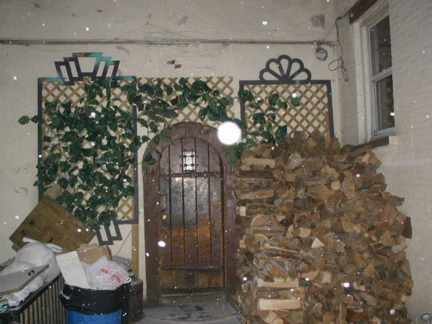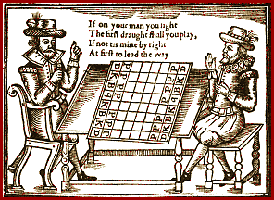|
A dear friend of mine sent me a scan of a page from a WWII era issue of Chess
Review depicting an article called Skeletons in the Chess Closet by Clyde
Hall. Normally, I prefer text to a scan, but in this instance, seeing the actual
page directed my attention to an advertisement in the original issue that I
would have missed otherwise -

I've written about different chess
clubs and cafés, from the Café de la Régence to The Manhattan Chess Club to Lisa
Lane's Queen's Pawn to the Franklin Chess Club to Kiev's Warsaw Café to San
Francisco's Mechanic's Institute, over time and these places still pique my
interest. Not being NYC savvy, I had never heard of Chumley's and didn't realize
it was, in fact, a landmark. Just this past April it closed due to severe
structural problems but seemingly has plans to re-open some indefinite time in
the future. I looked into the history of Chumley's hoping to find some chess
stories. What I found was it's unusual history and an unexpected and
indirect connection to chess.
Chumley's entrance at Pamela Court
 The
building at 86 Bedford St. was erected around 1830 as a blacksmithery. During
the Civil War it supposedly housed runaway slaves and eventually became a place
of gathering for left-wing factions. It became a tavern and actually burned down
in 1905 only to be rebuilt. In 1922, Leland (Lee) Chumley used the site as
a speakeasy, serving up alcohol and gambling. Like most speakeasy's it had to
keep it's existence, if not entirely secret, at least non-obvious, so no sign or
identification marked it's out-of-the-way entrance - at Pamela Court accessed
via a small passageway from Barrow Street. While speakeasy's went the way of
zoot-suits, Chumley's retained the tradition of no signs and the inconspicuous
entrance, making it hard-to-find, but often-sought-out. Both during and after
the Prohibition, Chumley's was one of the more popular hang-outs for writers,
both aspiring and famous. On the walls are mounted covers from numerous books
that they claim were written in part in that tavern. Portraits and photographs
of well-know customers fill another wall. Willa Cather, Ernest Hemingway, e.e.
cummings, Norman Mailer, Theodore Dreiser, William Faulkner, Ring Lardner, Edna
St. Vincent Millay, Philip Wylie, William Seabrook, Heywood Broun, Elmer Rice,
Howard Scott, Eugene O'Neill, Allen Ginsberg, John Dos Passos, John
Steinbeck, Willie Pogany, cartoonist C. D. Batchelor; Rex Stout, Stark
Young, Edna Ferber, James T. Farrell - all came to Chumley's. The
building at 86 Bedford St. was erected around 1830 as a blacksmithery. During
the Civil War it supposedly housed runaway slaves and eventually became a place
of gathering for left-wing factions. It became a tavern and actually burned down
in 1905 only to be rebuilt. In 1922, Leland (Lee) Chumley used the site as
a speakeasy, serving up alcohol and gambling. Like most speakeasy's it had to
keep it's existence, if not entirely secret, at least non-obvious, so no sign or
identification marked it's out-of-the-way entrance - at Pamela Court accessed
via a small passageway from Barrow Street. While speakeasy's went the way of
zoot-suits, Chumley's retained the tradition of no signs and the inconspicuous
entrance, making it hard-to-find, but often-sought-out. Both during and after
the Prohibition, Chumley's was one of the more popular hang-outs for writers,
both aspiring and famous. On the walls are mounted covers from numerous books
that they claim were written in part in that tavern. Portraits and photographs
of well-know customers fill another wall. Willa Cather, Ernest Hemingway, e.e.
cummings, Norman Mailer, Theodore Dreiser, William Faulkner, Ring Lardner, Edna
St. Vincent Millay, Philip Wylie, William Seabrook, Heywood Broun, Elmer Rice,
Howard Scott, Eugene O'Neill, Allen Ginsberg, John Dos Passos, John
Steinbeck, Willie Pogany, cartoonist C. D. Batchelor; Rex Stout, Stark
Young, Edna Ferber, James T. Farrell - all came to Chumley's.
The April 12, 1935 edition of the NY Times read:
Lee Chumley — “Soldier, Artist, Writer and Covered Wagon Driver” — dies
at 50. Born in
Chattanooga, Tenn., he studied art in Denver and Chicago. “During the last 10
years he was well known in
Greenwich Village and was usually seen dressed in a floppy hat, open shirt and
wavy necktie.”
See:
Remembering Chumley's
Chess and other games were played at Chumley's
as the ad above indicates. A 1959 article claimed, "Chess
and checkers are the favorite timekillers here and manager Ray Buillano
sometimes participates in as many as
four checker or chess games simultaneously while doubling behind the bar."
A curiosity in the very next year
involved Chess at Chumley's -
According to a June 2, 1960 story in the NY Times (page 22):
SLAIN OVER CHESS GAME;
Writer Killed During Fight in 'Village' Bar
June 1, 1960: Clinton Curtis, 43, a freelance
writer, is killed in a brawl over
a chess game at Chumley's. Michael L. George, a 34-year-old seaman whom
Curtis had just defeated, broke a beer glass against Mr. Curtis's neck,
cutting
his jugular vein, the police said.
However, the most intriguing story involves a
famous chess master not playing chess.
The chess master was Edward Lasker.
While not directly related to the Great Emanuel Lasker, Edward was a superb
player and a mathematician in his own right. Lasker was born in Kemplen (located
just 30 km from Düsseldorf), Germany in 1885, emigrated to the U.S. at the start
of WWI and took up residence in NYC.
From an article entitled How The
Young Edward Lasker Learned About Go by Jerald E. Pinto and published in the
June, 1981 issue of The American Go Journal, we learn that Edward Lasker
became interested in the game of Go while a student in Berlin.
One day I was at the library of the
University of Berlin. At that time, that is, in 1905, I was a student of
electrical engineering. With me at the library was a fellow student, a
mathematician, and we happened on a large magazine with a treatment of Go. [Oskar
sbc] Korschelt [who helped popularize Go in Europe sbc],
the author, gave many old Japanese games and explained the game quite
thoroughly, but what struck us was the article's title :Das Go Spiele, ein
Konkurrent des Schachs, that is 'Go: A rival of chess' [published in
the journal Mitteilungen der Deutschen Gesellschaft für Natur und Völkerkunde
Ostasiens in 1880 sbc] which seemed a humorous claim. Well,
we glanced through the article and learned the rules in the few minutes that
takes.
Then one day at the cafe in Berlin where the Chessplayers used to gather in the
afternoon my friend Max Lange and I saw a Japanese reading a Japanese paper, on
the back of which we noticed a Go diagram. We thought 'Well, that's remarkable';
we knew, of course, about chess columns, but Go columns? We didn't know what to
think, so we waited until the fellow was gone and took the paper down from the
newspaper rack. We put ourselves to deciphering the diagram. The problem lay in
decoding the Japanese numerals the diagram used, but although we hadn't actually
played more than a game or two of Go, we worked things out without too much
trouble. So we went through the game, but after 120 or 150 moves things came to
a stop, and there was some notation.
We waited until a few days later we saw another Japanese customer at the cafe,
whom we approached to ask whether he would mind telling us what that notation
meant. Oh, first it seemed obvious to us that it must say 'White resigns', since
Black had an enormous army and there didn't seem to be any reasonable
continuation for White, or else something like 'Game adjourned'. Well, the
gentleman said, 'Certainly, "Black resigns!" When we heard that we decided that
we would really have to give a good look at the game, and we took the newspaper.
About 3 weeks later Max Lange called to say that he had found a sacrificial
continuation for White ending in the capture of the Black army 22 moves later.
Then we really started to play Go in earnest.
Now it should be explained that the
Max Lange referred to here wasn't the Max Lange, the great player, writer
and analyzer (who had died in 1899) but rather his son, Max Lange the second,
who was born in 1883. Max Lange the younger even moved to Japan in 1920, an
unfortunate decision since three years later he was killed (along with about
140,000 others) in the Great Kantō earthquake of 1923. Lange had written one
book in 1914 entitled,
Das Schachspiel, und seine strategischen Prinzipien, which attempted to
apply mathematical principles to the understanding of chess.
So, what does all this have to do
with Chumley's?
As
Lasker himself explained:
In New York I met two men who knew
the game of Go. One was Mr. Karl Davis Robinson, and the other Mr. Lee Foster
Hartman, the editor of Harper’s Magazine. But when I went to live in Chicago and
did not return to New York until 1925, where we formed a little Go Club with Mr.
Robinson, Mr. Hartmann and a few others who we had interested in the game. Some
German players who had immigrated here after the war also joined, and gradually
we developed into quite a lively group of Go enthusiasts. We met once a week at
Lee Chumley’s, a well known restaurant in Greenwich Village. In 1934 I wrote an
elementary book on Go which Alfred Knopf’s publishing house brought out, and
many new addicts were brought into our circle through the book.
In his article
How
Go came to America, Milton N.Bradley of the Long Island Go Club, credits
this little Go group that met at Chumley's, during the Prohibition, with
being the first concrete and effective effort to establish Go in America.
|

